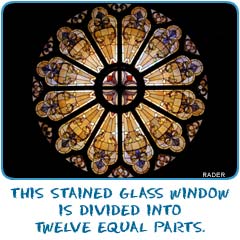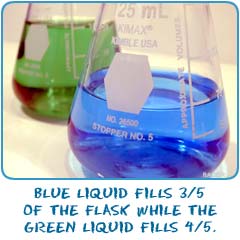
Breaking Down Fractions
Fractions are all around you. Bob ate half of a pizza. The store gave you a quarter for change. You have one can of a six-pack of soda left over. Fractions are there. But what is a fraction? It is a way of representing a number value that has been broken into equal parts. Is a fraction a division problem? Yes. Is a fraction a ratio? Yes. Is a fraction a decimal? It can be. Is a fraction a percentage? It can be after it is multiplied by one hundred. A fraction can become many numbers and every rational number can be written as a fraction. Does that help? Probably not.Let's look at the basics of fractions. A fraction is made of two numbers (integers), one on top of the other and separated by a line. You might see the fraction written as numbers with a slash between them also. In that case, the number on the left is the "top" and the number on the "bottom" is on the right. The top number is called the numerator and the bottom number is called the denominator. The top number represents the number of pieces you have and the bottom number represents the number of equal pieces there could be. Sometimes you might have a whole number to the left of the fraction. When you have those big numbers, the fraction is called a mixed number. A mixed number is a whole number and a fraction.
Examples:
4/9
• You have four parts.
• There could be nine equal parts.
• 4 is the numerator and 9 is the denominator.
3 4/9 (mixed number)
• You have three whole objects, and...
• You have four parts of a whole object.
• There could be nine equal parts of that whole object.
• 3 is the whole number, 4 is the numerator, and 9 is the denominator.
Related Activities

|
Identifying Fractions of Groups
- Play Activity |

|
Identifying Fractions of Shapes
- Play Activity |
Parts of a Whole
Fractions are numbers that represent a number of equal sized parts. If you are talking about halves, it means you took an object and broke it into two equal parts. When you work with thirds, there are three equal parts. Any object or number can be broken into any number of equal parts. You might have to do a fraction problem with one thousand seventy-thirds.Don't forget about the mixed numbers that use whole numbers and fractions. A value such as 3 5/7 means that you have three whole objects and five sevenths of a fourth object. When you learn more, you will know that this also means you have twenty-six sevenths (they are equivalent values). We work with mixed numbers all the time in fractions.

Finding Common Factors
Many functions with fractions will have you searching for common factors. You might need to simplify a fraction and turn 6/8 into 3/4. You need to know that 2 is a common factor for the numerator and the denominator. You might use factors when you add or subtract fractions. Adding the fractions 3/5 and 7/10 is difficult. But if you multiply the first value by a factor of two, you wind up with 6/10. Adding 6/10 to 7/10 is as easy as pie. Your answer would be the improper fraction 13/10 or the mixed number 1 3/10.Factors are natural numbers that can evenly divide into both the numerator and denominator. A fraction such as 17/25 does not have any common factors and it cannot be reduced. A fraction such as 16/24 is much different. The numerator and denominator share the factors 2, 4, and 8. If you reduce that fraction, you get 2/3. You divided the top and bottom values by 8. You'll get used to common factors as you use them more.
Related Activities

|
Comparing the Values of Fractions
- Play Activity |

|
Identifying Equivalent Fractions
- Play Activity |
Adding and Subtracting
You can add fractions and subtract fractions just like any other number. Some addition and subtraction problems are easier than others are. When you have a lowest common denominator, things go much easier. The simple description is that it's all about adding or subtracting the top values (numerators) when the bottom value (denominator) is the same for both fractions. We'll cover the details in a bit, but here are some examples:1/4 + 3/4 = 4/4
17/52 + 21/52 = 38/52 (could be simplified to 19/26 because of the common factor 2)
5/6 - 4/6 = 1/6
91/143 - 22/143 = 69/143 (no common factors)
Multiplying and Dividing
While multiplying fractions and dividing fractions are a little more difficult than adding and subtracting, it still involves simple processes. With multiplying, you multiply the numbers on top and bottom with each other. Dividing has you do a little flip-flop with the second value and then you multiply. Again, we'll go into details in a bit. Here are some examples.1/4 x 1/4 = 1/16 (See how the ones multiplied with each other and the fours multiplied with each other?)
1/6 x 5/7 = 5/42 (Tops with tops and bottoms with bottoms.)
1/4 ÷ 3/4 = 4/12 (We flipped the second value and then multiplied. The quotient could also be simplified to 1/3.)
1/6 ÷ 5/7 = 7/30 (Flip the 5/7. Multiply tops. Multiply bottoms.)
Look at the difference between multiplying and dividing the same values. Make sure you understand that the solutions are much different. 5/42 is much different than 7/30. The flip in division makes all the difference.
► NEXT PAGE ON FRACTIONS & DECIMALS
► NEXT STOP ON SITE TOUR
► RETURN TO TOP OF PAGE
► Or search the sites...
► NEXT STOP ON SITE TOUR
► RETURN TO TOP OF PAGE
► Or search the sites...

- Overview
- Number Types
- Factors
- Fractions
- Structure
- Reducing
- More or Less
- Mixed Numbers
- Mixed Numbers 2
- Addition
- Subtraction 1
- Subtraction 2
- Multiplication
- Division
- Word Problems
- Real World
- Decimals
- Percentages
- Estimation
- Ratios
- Money
- Activities
- More Maths Topics

Useful Reference Materials
Wikipedia:https://en.wikipedia.org/wiki/Fraction_%28mathematics%29
Encyclopædia Britannica:
http://www.britannica.com/topic/fraction
University of Delaware:
https://sites.google.com/a/udel.edu/fractions/


